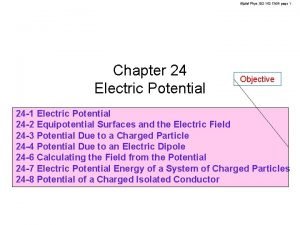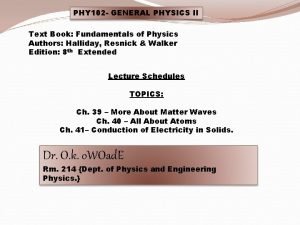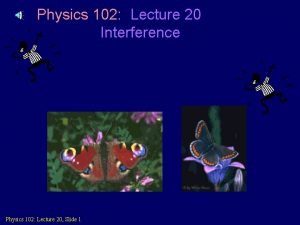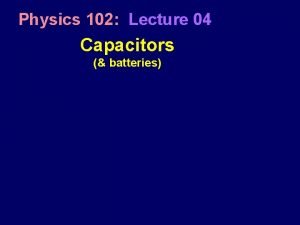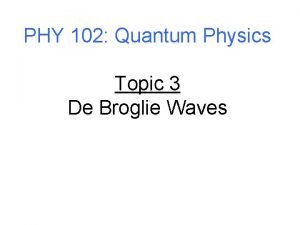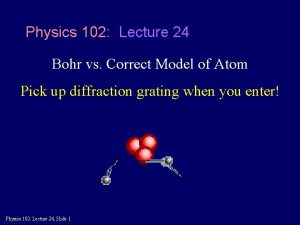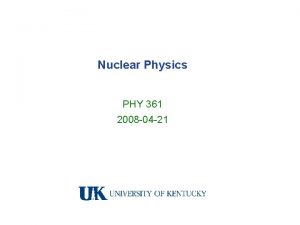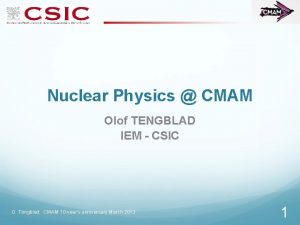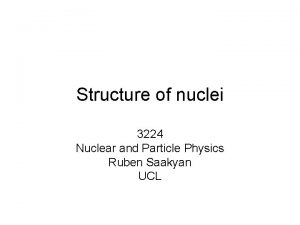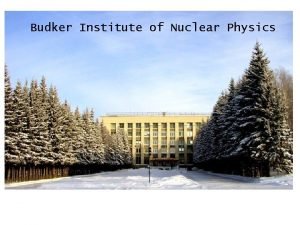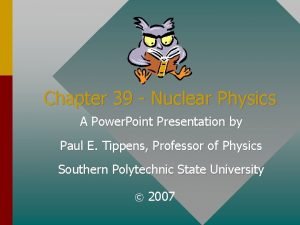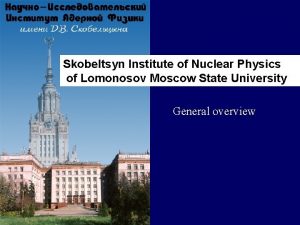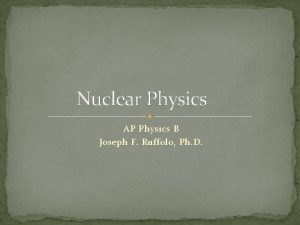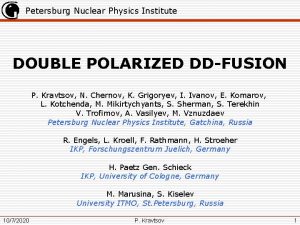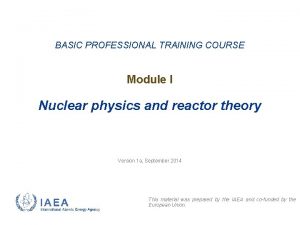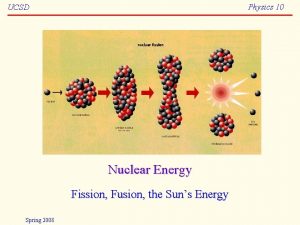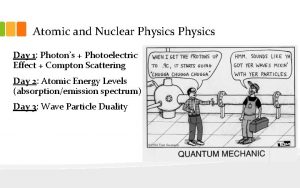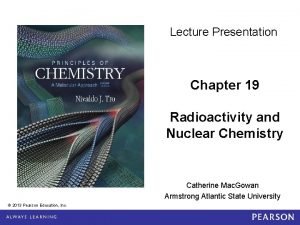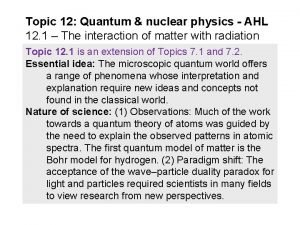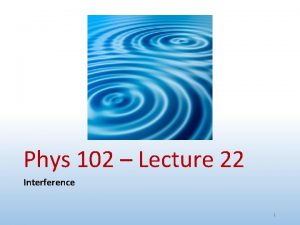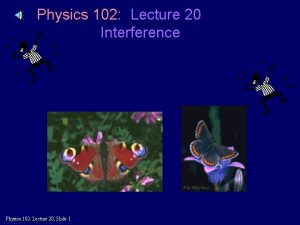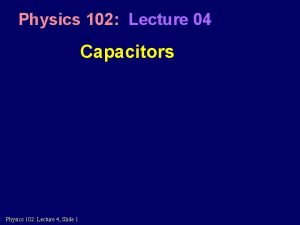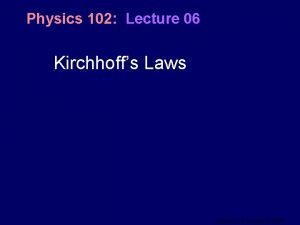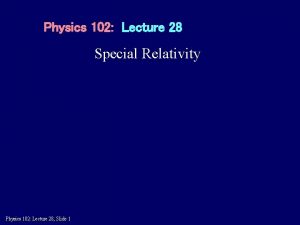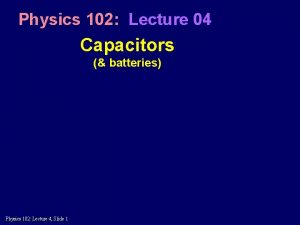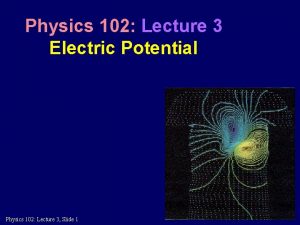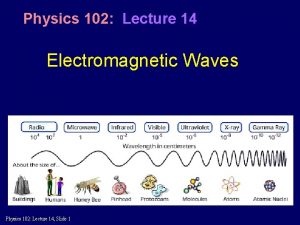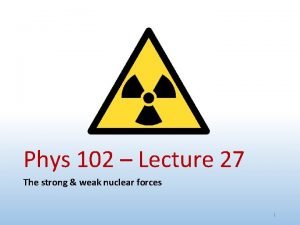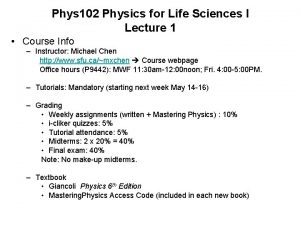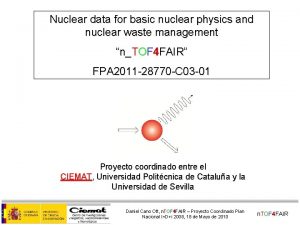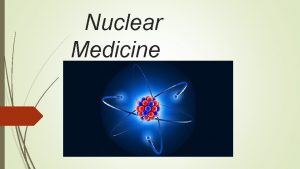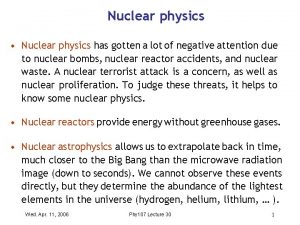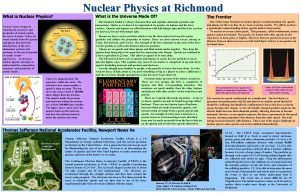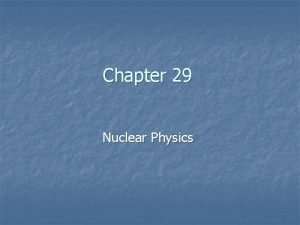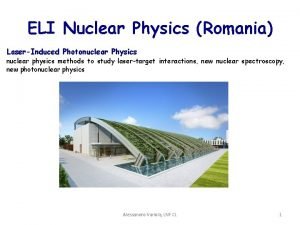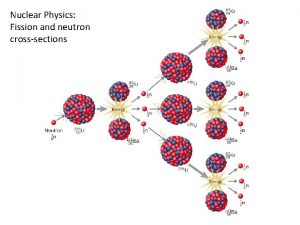Phys 102 Lecture 29 30 31 Nuclear Physics







































- Slides: 39

Phys 102 Lecture 29, 30, 31 Nuclear Physics and Radioactivity Key Points • Structure and Properties of the Nucleus • Alpha, Beta and Gamma Decays References 30 -1, 2, 3, 4, 5, 6, 7.

Atomic Structure Nitrogen (N) Atom The nucleus neutron proton

Structure and Properties of the Nucleus A nucleus is made of protons and neutrons. A proton is positively charged. Its mass is: A neutron is electrically neutral:

Structure and Properties of the Nucleus Neutrons and protons are collectively called nucleons. The different nuclei are referred to as nuclides. Number of protons: atomic number, Z Number of nucleons: atomic mass number, A Neutron number: N = A – Z. Therefore, A and Z are sufficient to specify a nuclide. Nuclides are symbolized as : X is the chemical symbol for the element; it contains the same information as Z but in a more easily recognizable form.

Structure and Properties of the Nucleus Nuclei with the same Z – so they are the same element – but different N are called isotopes. For many elements, several different isotopes exist in nature. Natural abundance is the percentage of a particular element that consists of a particular isotope in nature. For example, the most stable nitrogen isotopes are: nuclide symbol N(n) mass (u) Z(p) half-life 13 N 7 6 13. 005739 9. 965 min 14 N 7 7 14. 003074 Stable 99. 632% 15 N 7 8 15. 000109 Stable 0. 368% Natural abundance

Structure and Properties of the Nucleus Because of wave-particle duality, the size of the nucleus is somewhat fuzzy. Measurements of high-energy electron scattering yield: (30 -1)

Example 30 -1: of (a) , (b) Nuclear sizes. Estimate the diameter , (c) , (d). [Solution] Size of an atom ~ 10 -10 m

Structure and Properties of the Nucleus Masses of atoms are measured with reference to the carbon-12 atom, which is assigned a mass of exactly 12 u. A u is a unified atomic mass unit. Mass-energy relation: E = mc 2

Structure and Properties of the Nucleus From the following table, you can see that the electron is considerably less massive than a nucleon.

Binding Energy and Nuclear Forces The total mass of a stable nucleus is always less than the sum of the masses of its separate protons and neutrons. Where has the mass gone?

Binding Energy and Nuclear Forces It has become energy, such as radiation or kinetic energy, released during the formation of the nucleus. Again, E = mc 2. This difference between the total mass of the constituents and the mass of the nucleus is called the total binding energy of the nucleus. (The binding energy is the energy needed to break a nucleus into individual nucleons. )

i-clicker Binding Energy I What weighs more, an electron and a proton, or a hydrogen atom? 1) electron and proton 2) hydrogen atom 3) both the same

i-clicker Binding Energy I What weighs more, an electron and a proton, or a hydrogen atom? 1) electron and proton 2) hydrogen atom 3) both the same The total energy (or mass) of a hydrogen atom must be less than the energies (or masses) of the electron plus the proton individually in order for the electron to be bound.

Example 30 -3: mass compared to its constituents. Compare the mass of a its constituent particles. atom to the total mass of Appendix B gives the mass of neutral atoms, including the electrons outside the nucleus:

Binding Energy and Nuclear Forces To compare how tightly bound different nuclei are, we divide the binding energy by A to get the binding energy per nucleon.

Binding Energy and Nuclear Forces Example 30 -4: Binding energy for iron. Calculate the total binding energy and the binding energy per nucleon for , the most common stable isotope of iron.

Example 30 -5: Binding energy of last neutron. What is the binding energy of the last neutron in The binding energy of the last neutron (the energy needed to remove a neutron from ): ?

Binding Energy and Nuclear Forces The higher the binding energy per nucleon, the more stable the nucleus. More massive nuclei require extra neutrons to overcome the Coulomb repulsion of the protons in order to be stable.

Binding Energy and Nuclear Forces The force that binds the nucleons together is called the strong nuclear force. It is a very strong, but short-range, force. It is essentially zero if the nucleons are more than about 10 -15 m apart. The Coulomb force is long-range; this is why extra neutrons are needed for stability in high-Z nuclei.

Binding Energy and Nuclear Forces Nuclei that are unstable decay; many such decays are governed by another force called the weak nuclear force.

i-clicker The Nucleus There are 82 protons in a lead nucleus. Why doesn’t the lead nucleus burst apart? 1) Coulomb repulsive force doesn’t act inside the nucleus 2) gravity overpowers the Coulomb repulsive force inside the nucleus 3) the negatively charged neutrons balance the positively charged protons 4) protons lose their positive charge inside the nucleus 5) none of the above

i-clicker The Nucleus There are 82 protons in a lead nucleus. Why doesn’t the lead nucleus burst apart? 1) Coulomb repulsive force doesn’t act inside the nucleus 2) gravity overpowers the Coulomb repulsive force inside the nucleus 3) the negatively charged neutrons balance the positively charged protons 4) protons lose their positive charge inside the nucleus 5) none of the above The Coulomb repulsive force is overcome by the even stronger nuclear force! force

Radioactivity Towards the end of the 19 th century, minerals were found that would darken a photographic plate even in the absence of light. This phenomenon is now called radioactivity. Marie and Pierre Curie isolated two new elements that were highly radioactive; they are now called polonium and radium.

Radioactivity Radioactive rays were observed to be of three types: 1. Alpha rays, which could barely penetrate a piece of paper 2. Beta rays, which could penetrate 3 mm of aluminum 3. Gamma rays, which could penetrate several centimeters of lead We now know that alpha rays are helium nuclei, beta rays are electrons, and gamma rays are electromagnetic radiation.

Radioactivity Alpha and beta rays are bent in opposite directions in a magnetic field, while gamma rays are not bent at all.

Alpha Decay Example of alpha decay: Radium-226 will alpha-decay to radon-222

Alpha Decay In general, alpha decay can be written: Alpha decay occurs when the strong nuclear force cannot hold a large nucleus together. The mass of the parent nucleus is greater than the sum of the masses of the daughter nucleus and the alpha particle; this difference is called the disintegration energy.

Why Alpha Decay? Alpha decay is so much more likely than other forms of nuclear disintegration because the alpha particle itself is quite stable.

Alpha Decay Example : Uranium decay energy release. Calculate the disintegration energy when (mass = 232. 037156 u) decays to (228. 028741 u) with the emission of an α particle. (As always, masses given are for neutral atoms. )

Alpha Decay Example: Kinetic energy of the α in decay. For the above decay, how much of the 5. 4 -Me. V disintegration energy will be carried off by the α particle?

Alpha Decay One type of smoke detector uses alpha radiation from an isotope of americium – the presence of smoke is enough to absorb the alpha rays and keep them from striking the collector plate. The interruption in the flow of alpha rays triggers the alarm.

Beta Decay Beta decay occurs when a nucleus emits an electron. An example is the decay of carbon-14: The nucleus still has 14 nucleons, but it has one more proton and one fewer neutron. This decay is an example of an interaction that proceeds via the weak nuclear force.

Beta Decay The electron in beta decay is not an orbital electron; it is created in the decay. The fundamental process is a neutron decaying to a proton, electron, and neutrino: The need for a particle such as the neutrino was discovered through analysis of energy and momentum conservation in beta decay – it could not be a two-particle decay.

Beta Decay Neutrinos are notoriously difficult to detect, as they interact only weakly, and direct evidence for their existence was not available until more than 20 years had passed. The symbol for the neutrino is the Greek letter nu ( ); using this, we write the beta decay of carbon-14 as:

Beta Decay Example : Energy release in decay. How much energy is released when decays to by β emission?

Beta Decay Beta decay can also occur where the nucleus emits a positron rather than an electron ( + decay): And a nucleus can capture one of its inner electrons (electron capture):

Beta Decay In general, we can write beta decay in the following form: And similarly for electron capture:

Gamma Decay Gamma rays are very high-energy photons. They are emitted when a nucleus decays from an excited state to a lower state, just as photons are emitted by electrons returning to a lower state.

Conservation of Nucleon Number and Other Conservation Laws A new law that is evident by studying radioactive decay is that the total number of nucleons cannot change.
 Uiuc phys 102
Uiuc phys 102 Aljalal phys 102
Aljalal phys 102 Aljalal phys 102
Aljalal phys 102 Physics 241 purdue
Physics 241 purdue Lesson 15 nuclear quest nuclear reactions
Lesson 15 nuclear quest nuclear reactions Fisión nuclear vs fision nuclear
Fisión nuclear vs fision nuclear Physics 102
Physics 102 Physics 102
Physics 102 Physics 102 final exam
Physics 102 final exam Physics 102
Physics 102 Electric potential lecture
Electric potential lecture Physics 102
Physics 102 Physics 102
Physics 102 Physics 102
Physics 102 01:640:244 lecture notes - lecture 15: plat, idah, farad
01:640:244 lecture notes - lecture 15: plat, idah, farad Nuclear physics
Nuclear physics Scattering cross section in nuclear physics
Scattering cross section in nuclear physics Nuclear physics
Nuclear physics Magic number in nuclear physics
Magic number in nuclear physics Nuclear physics
Nuclear physics Nuclear physics
Nuclear physics Budker
Budker Nuclear physics topics for presentation
Nuclear physics topics for presentation Skobeltsyn institute of nuclear physics
Skobeltsyn institute of nuclear physics Budker institute of nuclear physics
Budker institute of nuclear physics Nuclear physics b
Nuclear physics b Petersburg nuclear physics institute
Petersburg nuclear physics institute Nuclear physics
Nuclear physics Nuclear fission
Nuclear fission Nuclear physics day
Nuclear physics day Nuclear magic numbers
Nuclear magic numbers Quantum nuclear physics
Quantum nuclear physics Quantum and nuclear physics
Quantum and nuclear physics Physics 101 lecture notes pdf
Physics 101 lecture notes pdf Physics 111 lecture notes
Physics 111 lecture notes Wave motion physics notes pdf
Wave motion physics notes pdf What is a harmonic wave in physics
What is a harmonic wave in physics Atmospheric physics lecture notes
Atmospheric physics lecture notes Physics 101 lecture 1
Physics 101 lecture 1 Tsms phys ed
Tsms phys ed

